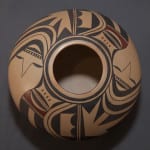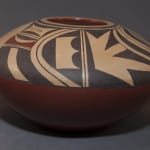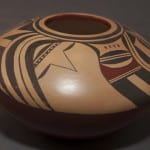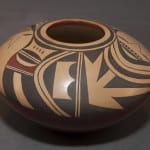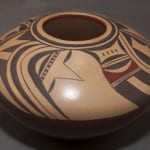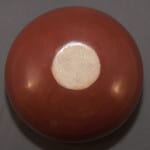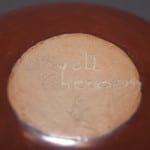This seedjar has very even walls and is made with grey clay (fires beige) to which Lowell has added micaceous material. Thus the inside of the seedjar and the unpainted surface of the top glitters. This appears to be the same clay Lowell used to form pot 2011-24.
The bottom half of the pot is painted with a yellow slip that fires an unusual dark red-maroon color. This slip appears to be identical to that used by Loren Ami on his canteen (2011-23), which may be the case since both were trained by Dextra. Unlike Loren, Lowell did not to add micaceous material to the red slip. The same red slip is used on the edge of the lip and in one small area of the painted design.
The top of the seedpot is filled with traditional Sikyatki Revival designs, repeated twice. Most recognizable is a version of the “clown” image that Lowell’s Great-Great-Great Grandmother Nampeyo used extensively (Kramer 1996:188). Many of the design elements swirl in a counterclockwise direction, which gives the design some energy. The painting is quite carefully done, but the overall design does not adhere into a unified theme. This is not an unusual pattern for Hopi-Tewa pots (see 1983-02), but the overall effect is only “pleasant” and not spectacular.


